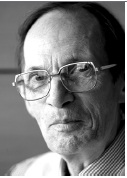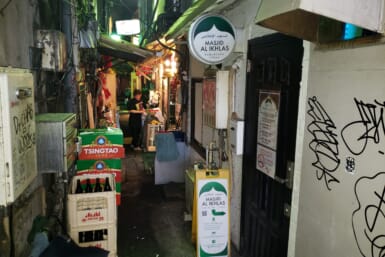I went out to Ogikubo the other day, to have a check-up. While hanging around in the waiting room, I overheard the doctor talking to a patient. Of course, I should not have been eavesdropping, but Japan is a place where there’s always someone listening in. This is the stuff of every Kabuki play under the sun.
So what was the hot topic? Not the patient’s health. In fact, not a private matter at all. These two people had been watching TV, and they had seen Minoru Mori in interviews. Just what was all this fuss over his Roppongi Hills development? The Apr. 25 opening of Japan’s largest property development had caught them by surprise.
“Such a hullabaloo,” grumbled the patient.
“Yes,” said the doctor. When it was my turn, I asked our doctor whether she had visited Roppongi Hills. No, she replied. What did she know about the development? Well, nothing. But the buzz on TV had got to her. It was all so unexpected. This $4.7 billion complex had mushroomed up out of nowhere, as far as she was concerned. But the media hadn’t conveyed very much info to her. She didn’t have any idea of the layout, or what was starting when, or the existence of a big Virgin Cineplex.
My point is that these are very early days for the most exciting development in Tokyo in my time—meaning since the Tokyo Olympics of 1964. That event, of course, was on a titanic scale. It totally out-ranked Roppongi Hills in terms of media attention. Then there was a closing ceremony; the athletes all went home, and all we had left to remind us that there had been an Olympic Games was the Olympic Village, a bunch of unimportant buildings in the park—and Tange’s Olympic Stadium. The show was over, and that was it.
Roppongi Hills, by contrast, is with us for good. And what is the report? First, the numbers. One million people visited the place in the first five days. I don’t know what that tells you. But what it said to me—I was there—was that the place is so darned huge, you can put 100,000 people into it, at any given moment, and it feels relatively empty, still.
Those 26 acres—or is it 28 acres? —I get confused by the numbers, absorb a crowd, and they’re all but gone. The space is much bigger than most of us dreamed.
This, to my mind, is what has given the Japanese media pause. They can’t get their heads around the simple fact that Roppongi Hills is so huge, you can visit it a dozen times and still get lost in the honey-colored stone corridors on the outside, or in the shopping arcades inside.
“I still get surprised,” said Stuart Deeson, the rooms manager at the Grand Hyatt Tokyo Hotel, part of the new complex. “I still get taken aback by how big Roppongi Hills is, even coming here every day, for a year.”
Nothing is going to change my habits, after all these years. The Okura established itself as “my” hotel, right at the creation, in the 1960s. So the Grand Hyatt may not get my trade. But for the young and the well-heeled, it is now the hostelry in town.
I sat in the Grand Hyatt’s sushi bar with Kanji Ohashi, an old hand from Japan Airlines, now the president of the hotel, and I took in the clientele. They were a crowd that the Okura has not accommodated for at least a generation—slick. The women seemed to like the Grand Hyatt. OK, then, general manager Xavier Destribats has his hands full. I ran into him in the ¥470,000-a-night presidential suite, while I was checking out the rooms for The Economist’s Cities Guide (see www.economist.com).
He is one busy man. Can he sell his top floor suite—it has a 14-meter outdoor swimming pool—at that price?
Obviously, I don’t know. So much about Roppongi Hills is being tried for the first time. Take the Virgin Cinema complex. Who else in this town is running a bunch of movies up to 5 a.m.? I like the cinema, having tested it. The seats are big and roomy. Again, it’s for a young crowd—the ones who carry in popcorn by the bucketful. Everything is cheap—my seat cost me ¥1,000, well below the average movie ticket price in Tokyo.
The Virgin space is built for speed and it’s built for youth. That goes for the whole complex. The people selling the ¥2,500 tickets for the complex tour—including a panorama of Tokyo from the top of the 54-story Mori Tower—are all of 20. The customers, on the other hand, are families. So you see a hefty sprinkling of visitors in their 30s, 40s and 50s, taking the kids out, or wandering about.
Instinct says that all of the above is going to work, and that, as people settle down, it will go like clockwork. My one concern at this point is the neighborhood. Roppongi has gotten to be really rough these days. In his Weekender column Bill Hersey has been sounding the alarm about Roppongi deterioration for years. It’s lost becoming as gaudy and unruly as Times Square before Rudy Giuliani’s time as mayor of New York.
Here’s the conclusion. Tokyo City and the Minato Ward office—along with the Keishicho (the Tokyo police) and the Keisatsusho (National Police)—have to take action. What we have in Roppongi in the small hours is a pullulating mess of prostitution, drugs and yakuza / Nigerian gang mayhem. Either the police get their act together—there being things they can do—or Roppongi Hills may suffer.
I’ve walked by Roppongi Crossing of an early morning—several times in the last couple of weeks, a couple of hours after daybreak—and the streets there stink.
There is, to be sure, a convenient subway exit from Roppongi Station, leading straight into Roppongi Hills, and avoiding the scrum around the crossroads. But lots of people don’t know about that as yet. They still get out at the crossing and trudge through the motley crowd hanging out.
What we have is “a tale of two cities,” as a writer for the Asahi remarked the other day.









